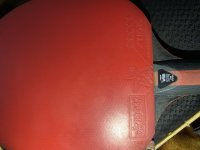This user has no status.
This user has no status.
Member
Epid3xia, I'm not sure how long you've been playing, but I am going to assume that you have been playing several years at least and already have a solid foundation in modern offensive table tennis. I will also assume that part of the reason you started the thread is because you believe that if your strokes were more like Ma Long/ZJK/FZD and other top Chinese players, you would probably play better -- especially the way they hit their forehands.
And, if I am correct about that, then I respectfully suggest that it is already too late to make any substantive change in the overall shape of either your forehand or backhand and that any attempt to do it would take years if you succeeded at all. Chinese players strokes are shaped the way they are from childhood, and I think it is in equal parts a product of training techniques and the use of hard tacky rubbers on relatively slow blades in kids.
The best thing you can do is refine what you have and make it better by training to make it completely automatic and reliable, which also means getting physically stronger, fitter, etc.
In other words, if you train like Chinese players do, you will make massive improvements even with very European strokes. Is this possible where you live and can you fit it into the rest of your life? Depends a lot on your clubs and coaches and your work or job, and willingness to subject yourself to it. Personally, I would love to take about 6 months off and just do that, just to see what would happen.
Lacking that, for me personally, I win a lot more when I keep Appelgren in mind, and Persson. And Primorac. I'm not you, I am older and slower, but I know a lot of kids who are not going to be professional players but who would win a lot more if they thought a bit more in terms just keeping the damn ball on the table, which doesn't necessarily mean playing soft all the time, it means always playing in a way that keeps you in balance and ready, while keeping your opponent off balance.
I am increasingly convinced that staying in balance during a point is one of the single most important things amateur players can improve.
Thank you for your worries!
My natural style of playing the ball was already a more "chinese" aproach at the beginning of me playing TT and that made it easier for me to teach things by myself with mirrors and shadow work and slow motion videos of chinese players to shape and direct my motion slowly into the direction of the "chinese" approach. I alternated a lot between shadow work, watching slow motion footage and playing the ball with a partner. And so I could shape my general approach of my forhand and footwork.
It was and still is great fun for me to do it by myself. It helps me to train my eye to observe and see what details lay in these complex motions and I understand a lot more of what I am doing. And I lov to develop a more claer feeling on how my motions are. It is great fun for me to always improve and learn new little things in my motions. I guess that's one thing I love so much about TT: always improving myself and learning new stuff.
Last edited:











